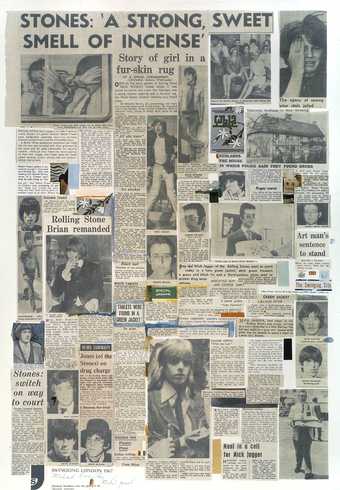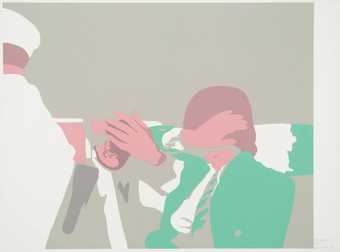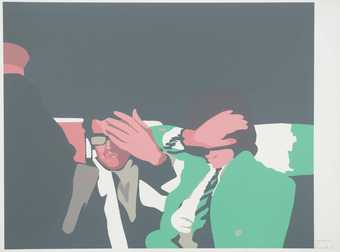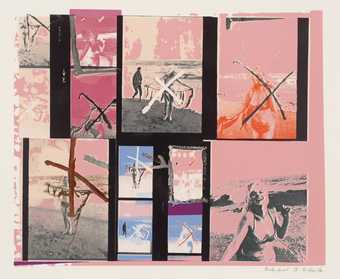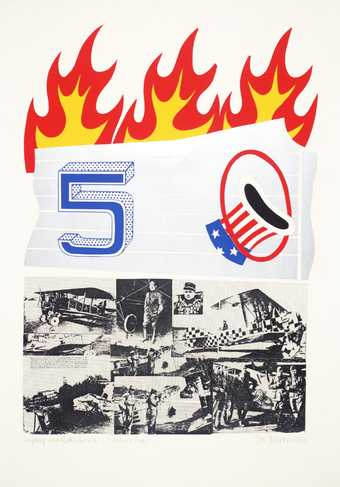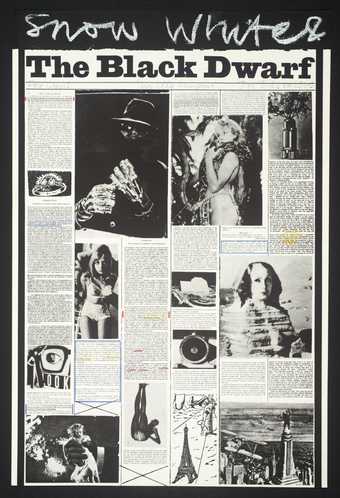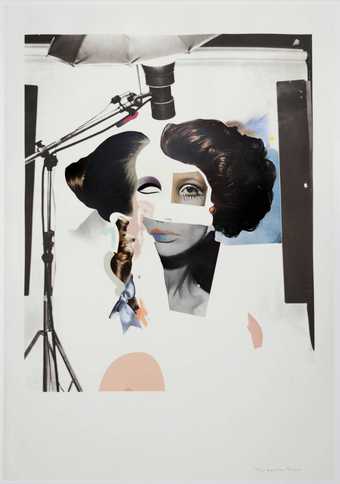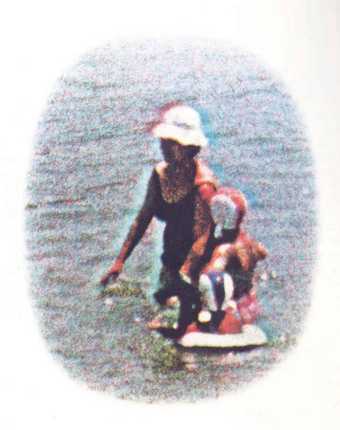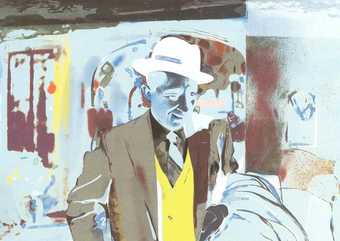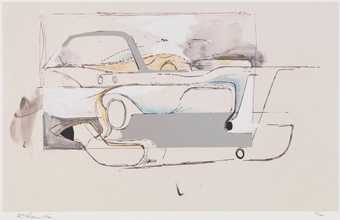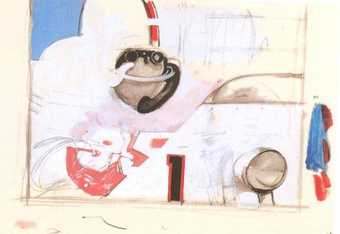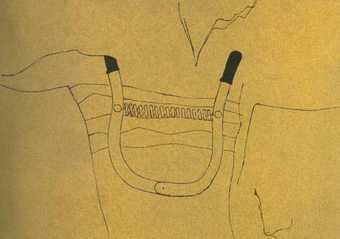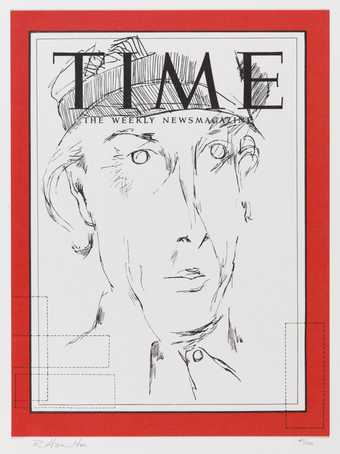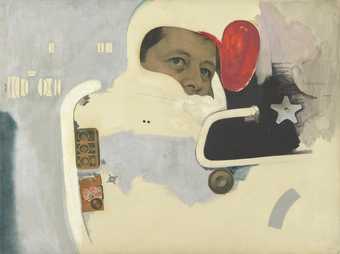
In Tate Britain
- Artist
- Richard Hamilton 1922–2011
- Medium
- Screenprint on paper
- Dimensions
- Image: 610 × 816 mm
- Collection
- Tate
- Acquisition
- Presented by Rose and Chris Prater through the Institute of Contemporary Prints 1975
- Reference
- P04247
Summary
The print Adonis in Y fronts is a based on a painting of the same title that is one of a group of four works made in 1962-3 under the umbrella title Towards a definitive statement on the coming trends in men’s wear and accessories. The Adonis in Y-fronts painting, made in 1962 (Art Institute of Chicago), is the third in the series. The print is distinguished from the painting by the removal of the hyphen in its title. Hamilton derived the group title for these works from a headline of a men’s fashion article he found in Playboy magazine. He added the word ‘towards’ to make it sound less ‘definitive’, explaining: ‘fashion depends on an occasion, season, time of day and, most importantly, the area of activity in which the wearer is involved. A definitive statement seemed hardly possible without some preliminary investigation into specific concepts of masculinity.’ (Quoted in Richard Hamilton, p.154.)
The image on which Adonis in Y fronts is based comes from an advertisement for Potenza expanders that Hamilton found in an issue of the body-building magazine, Mr Universo, from 1960. Hamilton’s painting and the subsequent print show the torso and lower face of a muscular man, holding a chest-expander to his body. The advert shows a full frontal view of the model’s chest to his waist; Hamilton elongated it to include his hips, twisting the body gently into a contra-posto pose. The man’s face, neck, shoulders and arms are reproduced as an enlarged version of the advertisement printed in halftone – black and white. The external contour of the athlete’s chest on his right side and the two alternative lines inside the external contour on his left side were drawn from a photograph of the sculpture Hermes with the infant Dionysus (Olympia Archaeological Museum) attributed to the Greek sculptor Praxiteles (fourth century BC) that the artist found in Life Magazine. Five horizontal bands in ochre and brown tones crossing the model’s upper chest were copied from a sweater shirt in an advertisement for Lucky Strike cigarettes. His lower chest, stomach and hips are bare paper, on which a stylized outline of the athlete’s underpants is printed. These ‘Y fronts’ are described by a narrow white seams in an ‘X’-formation joined to another white band at waist level under a red dotted line. The author of Hamilton’s catalogue raisonné, Etienne Lullin, has commented: ‘according to the advertising text, this “Y cut” would guarantee an especially comfortable fit’ (Lullin, p.58).
In the painting Adonis in Y-fronts, Hamilton coloured the ‘U’-form of the chest expander with gold metallic paint, fixing silver rivets into the canvas at the points where the expander hinges. In the print, the diagrammatic treatment of the spring between the two arms of the ‘U’ is extended to the ‘U’ itself. To the right of the figure, the background is covered with broad, silvery brushstrokes, emulating the original canvas. To the figure’s left, above a narrow band of dark textured paint, a monotone area of light grey extends into the figure in one of his broad chest stripes, emphasizing the illusionistic nature of artistic representation. The title Adonis in Y-fronts is a pun on the title of a 1962 pop song by the American singer Jimmy Clanton, Venus in blue jeans. For the artist, the y-fronts are the male counterpart to the Exquisite Form bra that features in his 1957 painting, Hommage à Chrysler Corp. (T06950).
Adonis in Y fronts is Hamilton’s first venture with a screenprint. The image recalls the muscle-bound body-builder who features, standing in a domestic interior, in the artist’s most famous work, the collage Just what is it that makes today’s homes so different, so appealing? (P20271 is a recent print version of this) that he created for the exhibition This is Tomorrow at the Whitechapel Art Gallery, London in 1956. As the title indicates, the four paintings in the suite Towards a definitive statement on the coming trends in men’s wear and accessories deal with the trappings of masculinity in the contemporary (1960s) world. The imagery is derived from current events and popular culture, as is usual in Hamilton’s work. Featuring an astronaut with the face of US President John F. Kennedy, a transistor radio-printed circuit and a fruitmachine dial, the first painting deals with man’s endeavours to conquer space and is subtitled with Kennedy’s famous words: Together let us explore the stars. The second painting combines car racing with American football and the New York stock exchange, and the fourth mixes attributes of each. Like the Adonis in Y fronts holding his chest-expander, all the heroes in these compositions are dependent on their accessories, machines and protective clothing for their achievements. The theme of men defined by their clothing and (mechanical) accessories recalls the bachelors in the lower panel of Marcel Duchamp’s Large Glass (T02011), the subject of intensive study by Hamilton during the 1950s and 1960s.
Making the print Adonis in Y fronts brought about Hamilton’s first working relationship with a master craftsman. The printer Chris Prater of Kelpra Studio, London was able to resolve several technical challenges presented by Hamilton’s ambition to reproduce the detailed brushstrokes on the painting’s right side in his print. The spring on the chest expander also required extra stages in the printing process. Adonis in Y fronts was screenprinted using twelve stencils on TH Saunders paper by the artist and Chris Prater at Kelpra Studio, London. It was produced in an edition of forty plus an unknown number of printer’s proofs, of which Tate’s copy is one. It is signed and inscribed by the artist in pencil ‘with thanks’. The edition was published by the artist.
Further reading:
Etienne Lullin, Richard Hamilton: Prints and Multiples 1939-2002, exhibition catalogue, Kunstmuseum Winterthur and Yale Center for British Art, New Haven 2003, pp.58-9, reproduced p.59 in colour.
Richard Hamilton, exhibition catalogue, Tate Gallery, London 1992, pp.80-81 and 154-6.
Richard Hamilton: Collected Words 1953-1982, Stuttgart and London 1982, pp.46-7, 53 and 106, reproduced p.107 in colour.
Elizabeth Manchester
October 2007
Does this text contain inaccurate information or language that you feel we should improve or change? We would like to hear from you.
Explore
- emotions, concepts and ideas(16,416)
-
- formal qualities(12,454)
-
- photographic(4,673)
- clothing and personal items(5,879)
-
- underwear(73)
- classical myths: gods and heroes(606)
-
- Adonis(12)
- equestrian and sporting(230)
-
- athlete(16)
You might like
-
Richard Hamilton Swingeing London 67 - poster
1967–8 -
Richard Hamilton Stage Proof 4
1972 -
Richard Hamilton Stage Proof 6
1972 -
Richard Hamilton Stage Proof 11
1972 -
Richard Hamilton My Marilyn
1965 -
Joe Tilson Lufbery and Rickenbacker
1963 -
Joe Tilson B - Snow White and the Black Dwarf
1969–70 -
Richard Hamilton Fashion-plate
1969–70 -
Richard Hamilton Vignette
1969 -
Richard Hamilton I’m dreaming of a white Christmas
1967 -
Richard Hamilton Hers is a lush situation (1957)
1982 -
Richard Hamilton Self-portrait (1965)
1982

